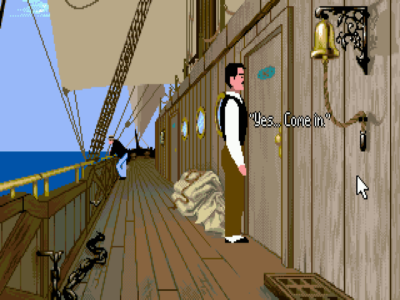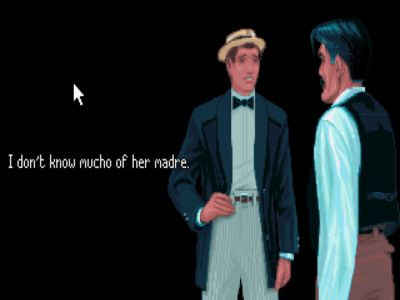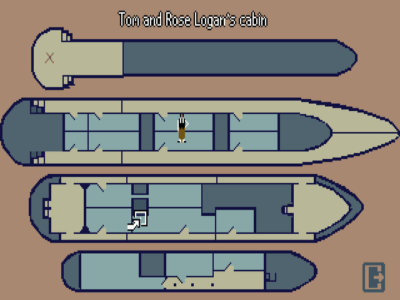
Cruise for a Corpse
Written by: Rik
Date posted: February 9, 2014
- Genre: Adventure
- Developed by: Delphine
- Published by: US Gold
- Year released: 1991
- Our score: 5
Despite some residual affection for Delphine’s previous adventures, Future Wars in particular, I somehow never got around to playing this one until now. From memory, I recall it receiving a lukewarm review from whatever Atari ST magazine I was reading at the time, assumed it represented the general consensus and never made it a priority to find out for myself.
That time, though, has now come, and as a semi-regular viewer of old Poirot episodes on ITV3 (the presence of Captain Hastings and Inspector Japp is a requirement, however, and I treat all other stories with suspicion) the 1920s murder-mystery setup is one that appeals. As French detective Raoul Dusentier you have been invited, without much explanation, onto the boat of a wealthy man named Niklos Karaboudjan for a short holiday. Almost as soon as you arrive onboard, your host is found murdered, and you are called upon to investigate. After a swift blow to the head knocks you out cold before you can even examine the body, you wake up on the floor with a murder to solve.

It’s polite to knock before you enter someone’s cabin, although if it’s empty and the door’s unlocked, get in there and start trying on some clot…er, I mean, look for clues.
At first glance it seems as if you are against the clock, and the time of day is a factor, but not necessarily in the sense that you’re likely to run out of time having spent too much of it faffing around or going down blind alleys. Your actions do move the clock forwards, but only those significant to the case will do so. Idly fondling another guest’s folded trousers, or repeatedly asking annoying and irrelevant questions will only waste your time in real life. Each time the game clock moves, items and characters will move around the ship, perhaps becoming available or unavailable in the process.
Much of the investigative process is conversation-based, and as you meet new characters, you have the option to pretty much question them about anything. Topics mainly revolve around other guests (or suspects, if you prefer) on the ship, although you can occasionally mention physical evidence you may have uncovered, and any other significant incidents that may have occurred. Once you find something, or meet someone, new, it’s worth going back and talking to everyone again to see if they have anything else to say. Equally, as the clock moves forward, you need to see if you have access to any new rooms or items of interest.
Suffice to say, such an approach necessitates endless wandering of the ship to find out what’s changed, and if there’s anything new to be discovered. Thankfully there’s a map screen that can be accessed at any time, allowing you to move Raoul around more directly, otherwise the bulk if your time would be spent trying doors and watching your hero trudge along the ship’s corridors.

Julio’s dialogue owes something to terrible British sitcoms. They want you to know he’s Spanish, I guess.
For the most part, conversation works well. Asking everyone about everything is no great chore, but often as you uncover new information you instinctively know whom best to seek out next. Searching for evidence, on the other hand, is a case of rather tedious trial and error, with some good old-fashioned pixel hunting thrown in for good measure. The interface itself is ok, an improvement on Operation Stealth certainly, with useable items highlighted by a change of symbol, and a click giving you a list of options, although said list often includes baffling and seemingly interchangeable verbs – do you really need open, search, inspect, examine and touch? A great many objects are of little use and serve only as red herrings; thankfully, you can only pick up items that are significant to the investigation.
Cruise for a Corpse‘s strengths lie mainly in the aesthetics, and it does most of what it sets out to do in this regard rather well. As a period whodunnit, it has most of the key ingredients in place (although my wife asked me to mention she thinks the name is terrible – to be fair, the phrase Croisière pour un cadavre may simply work better in French). The game looks very nice, with Raoul’s representation in polygon form for searching and as a sprite in close ups proving a smart move, the latter allowing for some deft facial shifts and arching of eyebrows that are really rather effective.
It’s also narratively superior to previous Delphine efforts (as it needs to be for a game relying more heavily on dialogue – although occasionally translation issues are rather apparent) and all the murder-mystery genre staples are here: a group of rich people spending time together for no particular reason, all with skeletons in their closets of some form or other – affairs, gambling, money problems, the lot – and they all turn on each other as the plot unravels. Flashbacks are also used effectively, peppered throughout the game as you uncover significant evidence or testimony.
(While we’re making favourable comparisons with other Delphine titles, it’s probably also worth mentioning that sensibly, and to my intense relief, the annoying arcade sequences from previous games have been all but removed here, save for one brief, easily circumvented example towards the end.)
As a mystery adventure, though, I’m not sure it’s altogether successful. Sometimes you can follow your nose, and the evidence, but in the main there’s rather too much aimless hunting around for something – anything – to move the clock forward. I’m not sure if it’s possible to completely screw things up for yourself so that progress is impossible (the manual, incidentally a useful source of background information, implores: “Every problem has a solution – ALWAYS” – so I’d assume not) but there will be times when it certainly feels like that. For me, the final revelations didn’t entirely satisfy, either, seeming rather a let down after all that had gone before.
Unlike the ST magazine that said whatever it was that put me off at the time, I’d judge this to be Delphine’s best adventure. However, by 1991 we were already into Monkey Island 2 territory, and held up against such a standard, Cruise for a Corpse seems dated and limited by comparison. The original setup and a few nice touches do make it worth a look though.



 Posts
Posts
Although you do mention it, keeping those stupid arcade scenes out is much more than the absence of a negative quality to me. It also implies that the game keeps its inherent pacing. Operation Stealth isn’t just bad, because the arcade scenes themselves are frustratingly unplayable, but also because they throw off any structure the game might have had before. Somehow, it seems you’re just being teleported from one of these scenes to the next without actually having made that progress yourself. In spite of its flaws, Cruise is much more successful insofar that it keeps the protagonist (and therefore, by proxy, the player) in control of what is happening.
February 9, 2014 @ 7:46 pm
They just feel like they don’t belong, don’t they? And any building level of involvement soon evaporates as you’re taken out of the main game and into some random, unrelated nonsense.
Also, while you could kind of understand them including action scenes in a sci-fi or spy caper, they really don’t belong here. Even the one sequence employed in this game didn’t really fit (although I found it more forgiving than previous examples, and of course there’s another way around it) – I’m not sure Raoul is a fist-fighting kind of guy.
February 10, 2014 @ 8:44 pm
Quite 🙂
I’m not sure what you’re trying to get at with the comparison right at the end of the review, though. By 1991, we were in Monkey Island 2 territory? Yes, that game had come out, but how many adventure games of *any* age can compare favourably to MI2? What you’re saying there could basically be held against every game: There’s always something better.
The bulk of genre releases at that time are inferior to Cruise, I’d say. It’s definitely too chatty and yes, there is too much aimless wandering until something unforeseeable happens, but in this way, it’s exactly like (for example) Broken Sword which these days is considered a great classic for some reason.
February 11, 2014 @ 8:11 pm
I think it’s fair enough to refer to one of the leading games in the genre when summing up, particularly if they came out in the same year, but I take your point – I guess it’s a bit of a lazy review convention that isn’t massively useful on its own.
I suppose what I was getting at was that although I enjoyed this game more than the other Delphine adventures, mainly because there has been an effort to flesh out the bits of the game that aren’t necessarily about solving the puzzles, which is something I always like (I wouldn’t say it’s too chatty – as I mentioned, I quite liked the conversation bits and although there are times when you forget what you’ve asked of whom, repeating it all isn’t a big deal), it’s still some way short of what I’d want in this regard. So while part of me was positive about the progress made, I had to remind myself that by this point there were some games out there – admittedly not many – that were already a long way ahead.
You are right, this is probably better than most similar games of the time, but I guess that’s not the angle we come at things at. I suppose, though, that I do have to cop to a heavy LucasArts bias and, based on the accumulating evidence over the years, perhaps I don’t get on with adventures as well as I thought I did! Something else I was playing recently (write-up to follow) certainly made me think that perhaps I’m not the best person to be poking around with the ageing lesser-lights of the genre.
Oh, and I do have a bit of a soft spot for Broken Sword, but not to the same extent that many others seem to…
February 16, 2014 @ 5:54 pm